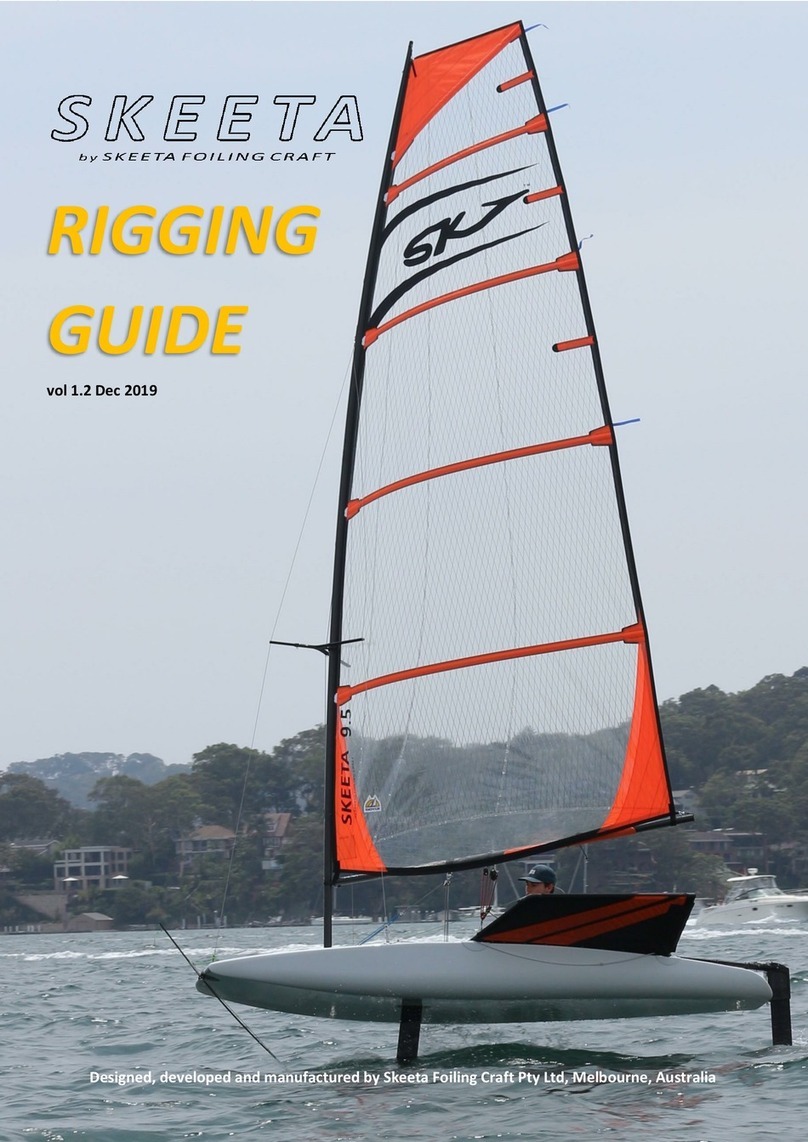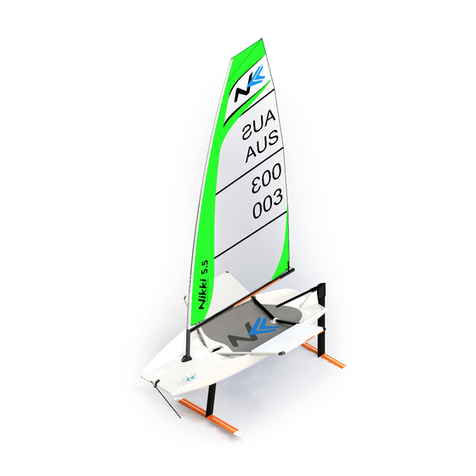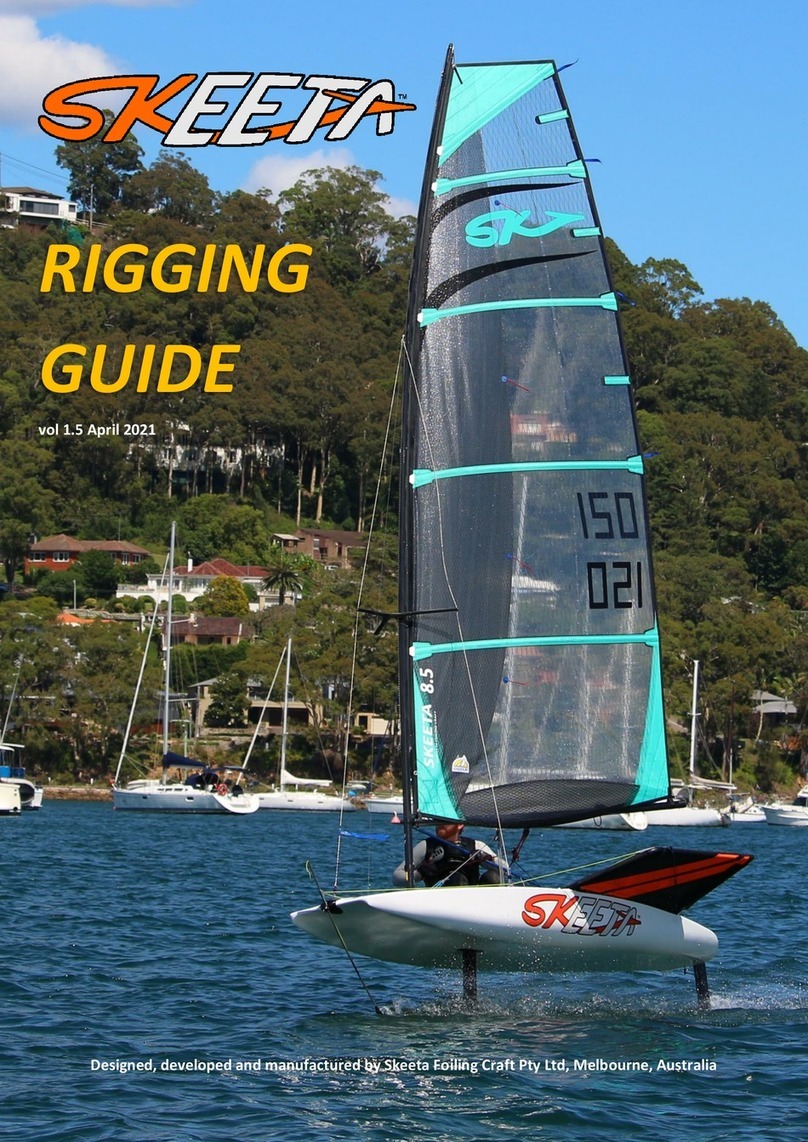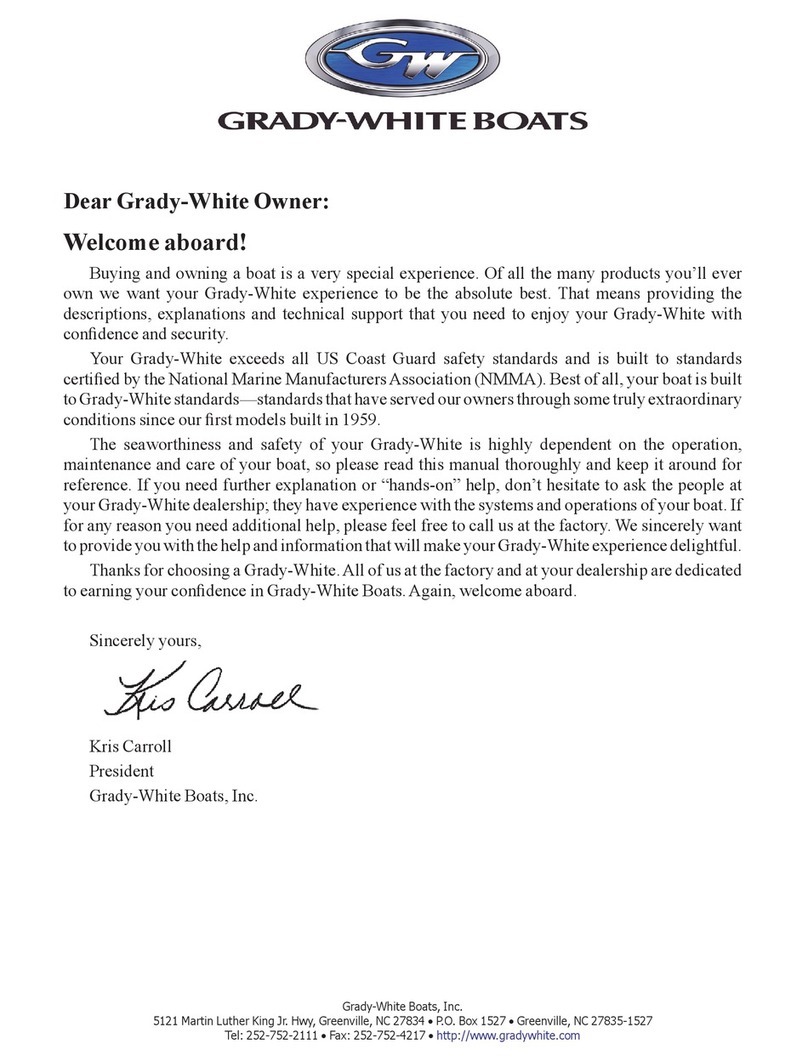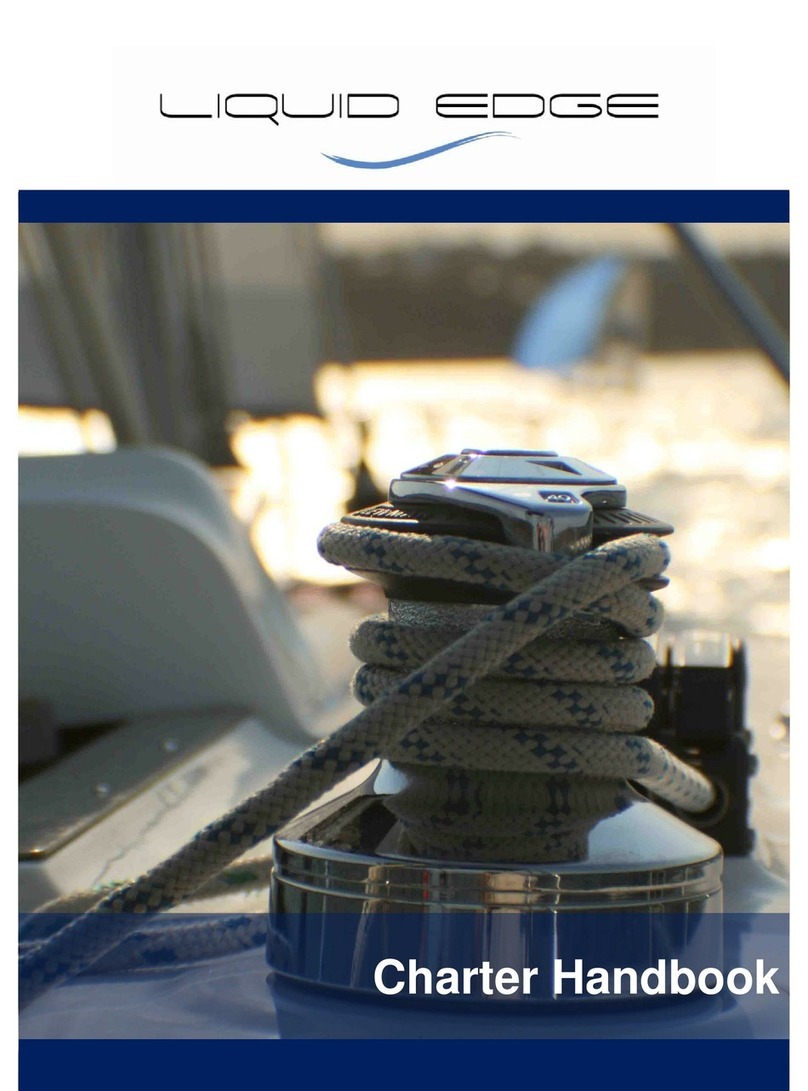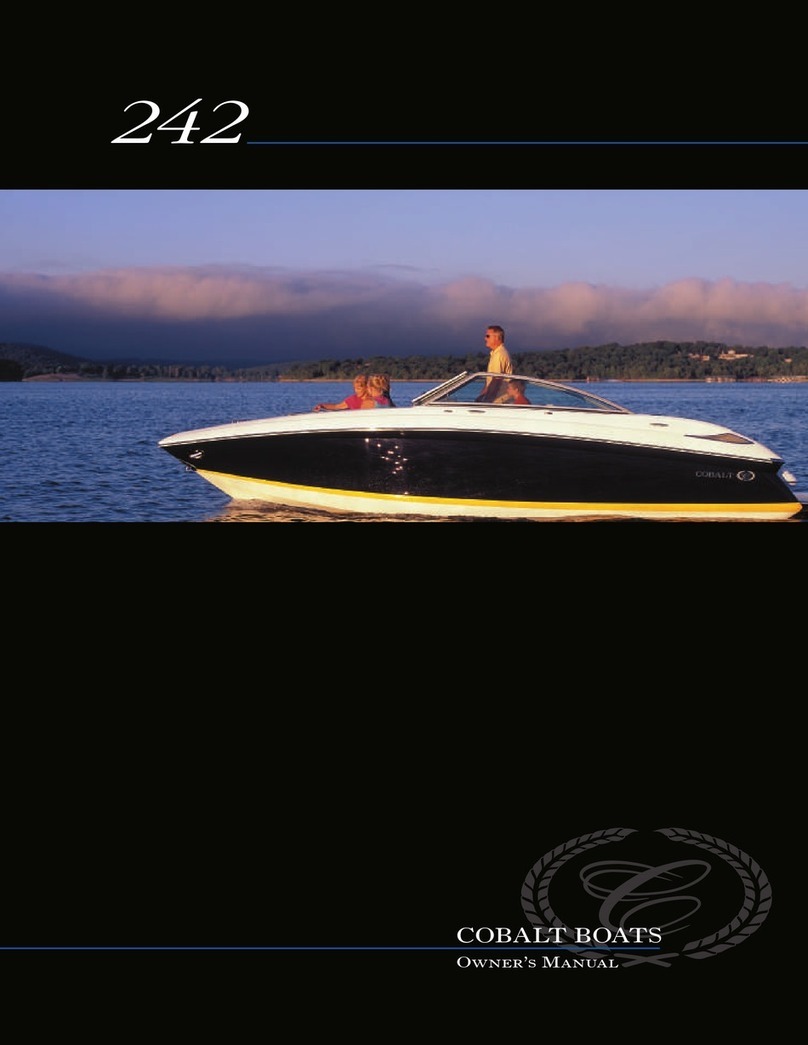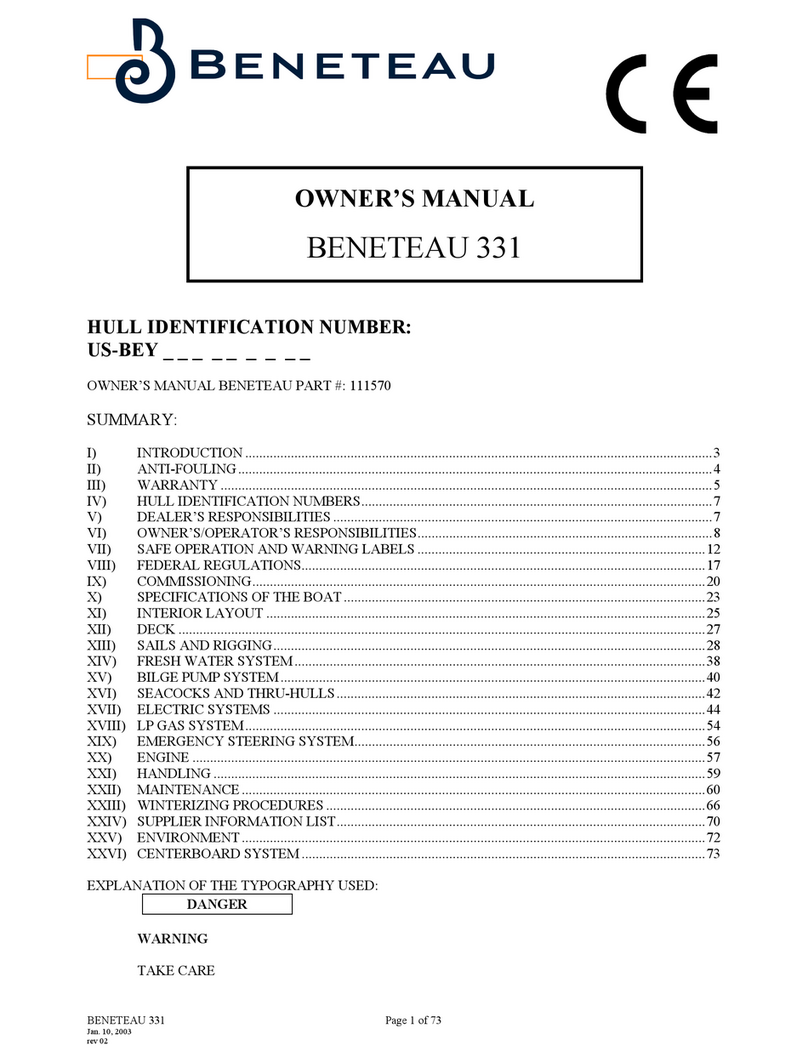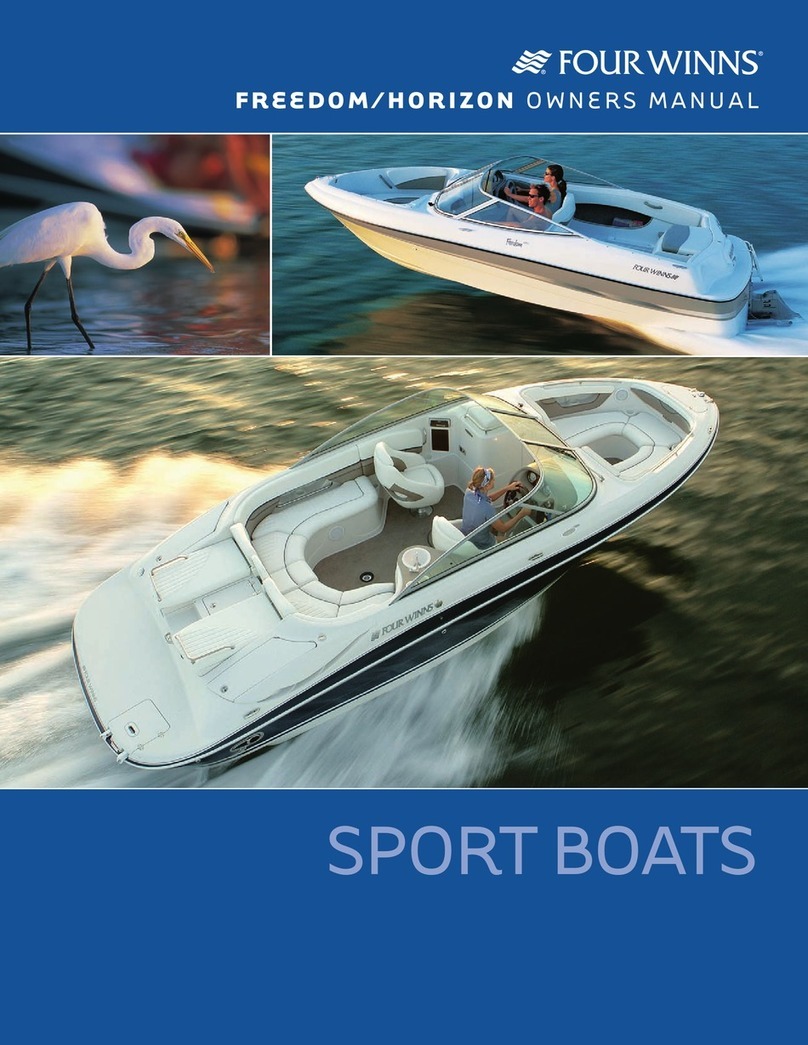SKEETA FOILING CRAFT NIKKI User manual

NIKKI / SKEETA
OPERATING
GUIDE
vol 1.2 Mar 2021

1
Index
Introduction
2
Sailing a scow
-Hull balance
-Light air sailing
-Planing upwind
-Planing downwind
2
Launching
3
Returning to shore and unrigging
3
Foiling for the first time
4
Sailing
4
Take-off
5
Steering for balance
6
Safety
-Safety gear
8
Caution
8
Capsizing
9
Towing
10
Printed on recycled paper

2
Introduction
This operating guide explains how to launch and sail, safety precautions and capsize recovery information
for both Nikki and Skeeta.
Information on how to assemble and rig your new Nikki or Skeeta is contained in the Rigging Guide.
Sailing a scow
Sailing a light scow is a lot livelier than most other dinghies.
It is important to understand the dynamics of the scow shape and how to sail effectively.
There is a significant benefit to sailing scows heeled to leeward, especially in light air, as this greatly reduces the
wetted surface area and drag. When heeled, the waterline becomes very narrow, just like that of a skiff or single hull
of a catamaran and these boats are quite fast, even upwind.
-Hull balance
Wide bow sections are a distinctive
feature of the scow hull shape. The heeled
waterlines typically remain parallel to the
centreline of the boat, so there is no net
steering effect of the hull as it heels. This
provides immense stability, while the
helm remains completely balanced. Not
only are scows a pleasure to sail at any
angle of heel, but they have a light helm,
are easy to steer and sail in any
conditions. Without the need to steer in
order to control the hull, the rudder can be
smaller, with less drag, making the boat even
faster and more manageable.
The centreline of the scow remains parallel
to the centreline of the boat, greatly
improving the helm when heeled.
-Light air sailing
In light air, the boat can be heeled well to leeward, sailing nicely in displacement mode on a single narrow, cat-like
hull. Buoyancy has been designed into the bilge, keeping the bow and stern well clear of the water to reduce drag.
The heeled hull effectively presents to the water a refined, light air displacement hull. The hollow tunnel hull shape
adds to this effect. The boat is a pleasure to sail and is fast, even in light air.

3
-Planing upwind
The large planing surface, along with a large sail area and wide powerful wings, produces a dinghy with the amazing
ability to “plane upwind”. Normally the preserve of trapeze driven high performance skiffs, the boat is fast, exciting
and fun to sail on the plane both upwind and down. There is no need any longer to slog to windward, leaning hard
for little result as with displacement dinghies, you plane all around the course!
It is really a whole lot of fun to sail in any safe conditions, especially on a reach in a solid breeze where it is much
faster than similar sized dinghies.
-Planing downwind
The hull is very light and easily driven, especially with its wide wings and large sail area. Just like a sailboard, the
planing surface has a flat run aft, making it very fast in planing conditions, skipping across the water in as little as 8-
10 knots of wind. The wide, stable hull makes it easy to handle, even in boisterous conditions.
Launching
Once your boat is rigged with the sail raised and foils retracted it is
ready to launch. On the trolley, wheel it into knee deep water and
gently slide the boat off the trolley.
Take extra care with the foils and the wand.
Push both centerboard and rudder down slightly, using the clamp
to hold them in position. Leave the wand fully retracted. Hop
aboard and sail away from the shore, just like a normal dinghy.
Once clear of the shore and in deeper water, ease the sheet,
release the clamp and lower the rudder by pulling the pull-down
rope and insert the retaining pin into the hole in the side of the
rudder box. Push the centerboard down fully and insert the
centerboard retaining pin as mentioned in the Rigging Guides.
Now attach the pushrod clevis to the bell crank on the centerboard
with the fast pin, and you are ready to go foiling!
Returning to Shore and Unrigging
When returning to shore;
1. Retract the wand fully.
2. Pull out the centerboard retaining pin and the clevis fast pin.
3. Raise the centerboard and rudder part of the way, leaving enough centerboard and rudder in the water for
steering. Apply the foil clamp to hold them in place.
4. When in shallow water, carefully get off the boat. Stand next to the boat and undo the halyard and lower the
sail.
5. Remove the wand from the bow mechanism and store in a safe place on the cockpit –you do not need to
unthread the wand rope at this stage.
6. The centerboard and rudder can be removed in the water.
Alternatively, you can leave them fully raised and the wand in the fully raised position, then gently place the
boat on the trolley. This enables the boat ready to sail again, simply by launching and hoisting the sail.
WARNING:
Be aware of the water depth or
damage to foils may result.

4
Foiling for the first time
Foiling dinghies provide a thrill unlike other forms of sailing. Managing the speed and acceleration is not a natural
reaction, even for experienced dinghy sailors. It is not something that everyone can master on their first attempt.
Remember your first time on a bicycle or sailboard which required some practice and persistence.
You should first start in light to moderate, steady winds and flat water on an open bay without too much traffic.
Even stopping requires some special skill! You will also, perhaps for the first time, experience true ‘apparent wind’
sailing and will be on the edge of control. You will need to be careful, patient and very persistent to get it right... but
you will be well rewarded!!
The unique wand system is a key innovation which enables the skipper to accurately select foiling height. Starting
from displacement sailing, the boat can begin to foil reliably and safely just off the water surface. This gives the
skipper a feel for foiling, limiting the risk of capsizing and crashing. The boat takes off with a rush but gives you time
to get used to the massive apparent wind changes. If you do make mistakes, the hull is able to provide stability
immediately. There is much less chance of crashing, as with other foilers.
As you get more confident with the special skills required for foiling, you can raise the ride height progressively,
getting higher, faster and even able to heel to windward for better upwind performance. If at any time you feel out
of control, you can raise the wand, even while you are on the wings. This acts as a safety device, immediately
lowering you to the water where you are once again under full control.
Skeeta Foiling Craft provides you with the equipment to experience foiling. Foiling competently requires practice and
is something we recommend you get training/coaching for.
Sailing
First up, it is a good idea to get the feel of the boat (without foiling), understanding how to sheet on, sail upwind and
downwind, trim the vang for power, tacking and gybing. Sailing a light scow is a lot livelier than most other dinghies.
You should then be ready to feel your way into foiling. Lower the wand around 300mm which should enable the boat
to just lift off and fly, just above the waves. This is the best way to begin as the boat remains stable and if you fall or
tip over, the boat helps you stay upright. It should feel easy and safe to sail.

5
With practice, you will gain the courage to lower the wand further, increasing the ride height. The boat will really
begin to fly, and you will need to find some completely new sailing skills.
Some of the things you will notice are that the boat remains stable, but all goes quiet save the swish of the foils and
wand as the boat accelerates well beyond the wind speed. This feels like low level gliding and is a surreal experience.
You will also, perhaps for the first time, experience apparent wind sailing. As you speed up, because the wind
direction moves forward, you will quickly need to adjust the sails to prevent the boat simply falling back into the
water as the sail luffs. You will need to respond quickly by bearing away and sheeting in, always steering to keep the
boat moving and prevent the sail luffing while steering to keep the foils under the rig. In stronger breezes you will
soon find yourself going very fast downwind with the sail sheeted in quite tight. Enjoy the rapid increase in speed
and sheer thrill. This is what foiling is all about!!
Once you get used to reaching, gradually head the boat up into the wind, pulling the vang on, sheeting in and leaning
harder. Allowing the boat to heel slightly to windward is one key to successful upwind sailing and requires some skill
to achieve. At all times you should use gentle, steady movements of the tiller, being over aggressive can make it
more difficult to stay foiling.
Take-off
Even experienced dinghy sailors, when new to foiling, tend to sheet on hard to gain speed which heels the boat to
leeward, then hike out hard to keep it flat. This does not result in take-off. The boat just heels over to leeward and
stays in the water... just like any dinghy in displacement mode.

6
To take-off successfully, it helps to sit fully out on the wings on a reach, then induce a small amount of windward
heel by momentarily easing the sheet, once heeled to windward, bear away and sheet on to accelerate while
bringing the rig over the centre of lift of the foils. The boat will then easily lift and accelerate.
**Make sure to sheet on quickly and bear away to keep the boat flying**
If you do nothing, the boat will just fall in to windward and you will get wet!
It is neither difficult, nor necessarily a matter of leaning really hard. Rather, a very subtle technique that happens
automatically with a little practice.
Steering for balance
Centreline foiling a dinghy is quite different to displacement sailing, it is very much like riding a bike where you steer
to keep your balance. When sailing in displacement mode, the righting arm is between the sailor’s weight and the
centre of buoyancy of the hull. Refer to the diagram below.
As the boat heels to leeward, the righting arm increases as the centre of buoyancy moves to leeward. This provides a
natural restoring force, stabilising the boat as it heels in either direction.
Once the boat lifts out of the water and is foiling, the centre of buoyancy is replaced with the centre of lift as the
new pivot point. As the hull is no longer in the water, the pivot point does not move as the boat heels and remains as
the centre of lift of the foils. This means the more you heel the boat to windward, the more righting moment you
have.

7
The consequence is the boat becomes unstable as it heels in either direction. Therefore, you need to actively balance
the forces to remain upright. This is quite the opposite of balancing a displacement dinghy and explains why the boat
feels so different to sail on foils.
In effect it is like balancing a stick on your hand or sitting on a bike. If you do not actively move your weight to
provide balance, or steer it, the boat will fall over.
Fortunately, the sail helps you a lot, providing something to lean against just as with a sailboard, which dampens the
movement and provides a restoring force. It is not sail trim alone which keeps the boat upright. A lot of the skill is in
steering with careful tiller movements, just to keep the rig over the lifting point of the foils. Steering aggressively is
not only slow but unbalances the boat.
We wish you many happy years foiling and sailing!
skeetafoilingcraft.com

8
SAFETY
If you do find yourself in a difficult situation: For example, heading for land, boats or people at high speed,
out of control! Simply reach for the wand cord and raise the wand. This incredible safety device lowers you
to the water immediately, slowing the boat and giving you full control. This way, you should not have to
bail out of the boat or capsize to prevent a collision.
CAUTION
Be aware of the following warnings/cautions:
Make sure you have only 1 person and appropriate
safety gear (up to 65kg for Nikki, up to 100kgs for
Skeeta) as stated on the plaque per boat.
There is a risk of capsize. Read instructions to right
Nikki and Skeeta below.
Obtain proper training and experience for sailing and
foiling craft.
Boats are recommended for sailing in up to 23 knots of
wind, in smooth conditions.
When Sailing, keep well clear of other boats, people, or
any obstacles in/on the water, especially when foiling.
When learning to foil, sail only in steady, gentle
breezes in smooth waters.
Design Category C –Inshore: Designed for voyages in coastal waters, large bays, estuaries, lakes and rivers
where conditions up to and including wind force 6, and significant wave heights up to, and including 2 metres
may be experienced.
Always check weather forecast before sailing.
Always sail within your abilities.
Sail with another boat/boats.
When Transporting your boat and accessories:
Make sure your roof racks and/or trailer, and car are fit for purpose, in good order and legally compliant.
Ensure your load is tied on securely.
SAFETY GEAR
For buoyancy, as well as impact protection,
wear full protective sailing gear and footwear:
Including fully padded Buoyancy Vest and helmet.
CAUTION:
The Mast is made of Carbon Fibre, which is an electrical conductor.
Take extreme care to keep away from and clear of overhead
powerlines and other obstacles.
Contact with powerlines or other electrical sources may be fatal!
Take care to avoid all other obstacles –on land and on water.

9
CAPSIZING
1. Locate and grab hold of the righting rope attached to the hull, underneath the wings.
2. Position yourself behind the centreboard, with your feet on the front bar of the wing close to the
hull.
3. Pull on the righting rope and lean backwards. This will raise the rig out of the water.
4. As the boat begins to become more upright, ensure you move to either side of the wings and out of
the way of the boat.

10
5. Move yourself to the back of the boat and lift yourself aboard.
TOWING
For towing, make sure the wand is retracted (see Tip below). Loop a towing rope around the base of mast
once or twice. Hold onto the end of the rope (do not tie off). The rescue vessel should tie their end of the
rope off onto the appropriate position.
Steer the boat making sure the towing rope isn’t touching the wand, as this may result in damage to the
wand.
For further questions or information, please contact your Dealer.
Skeeta Foiling Craft Pty Ltd, Melbourne, AUSTRALIA
skeetafoilingcraft.com
TIP:
When being towed with foils, it helps to pull the wand down about 200mm.
This allows the main foil to lift slightly to counteract the lift on the rudder foil and will
reduce the chance of nosediving.

11
This manual suits for next models
3
Table of contents
Other SKEETA FOILING CRAFT Boat manuals
Popular Boat manuals by other brands

Cantiere Del Pardo
Cantiere Del Pardo Grand Soleil 46.3' owner's manual
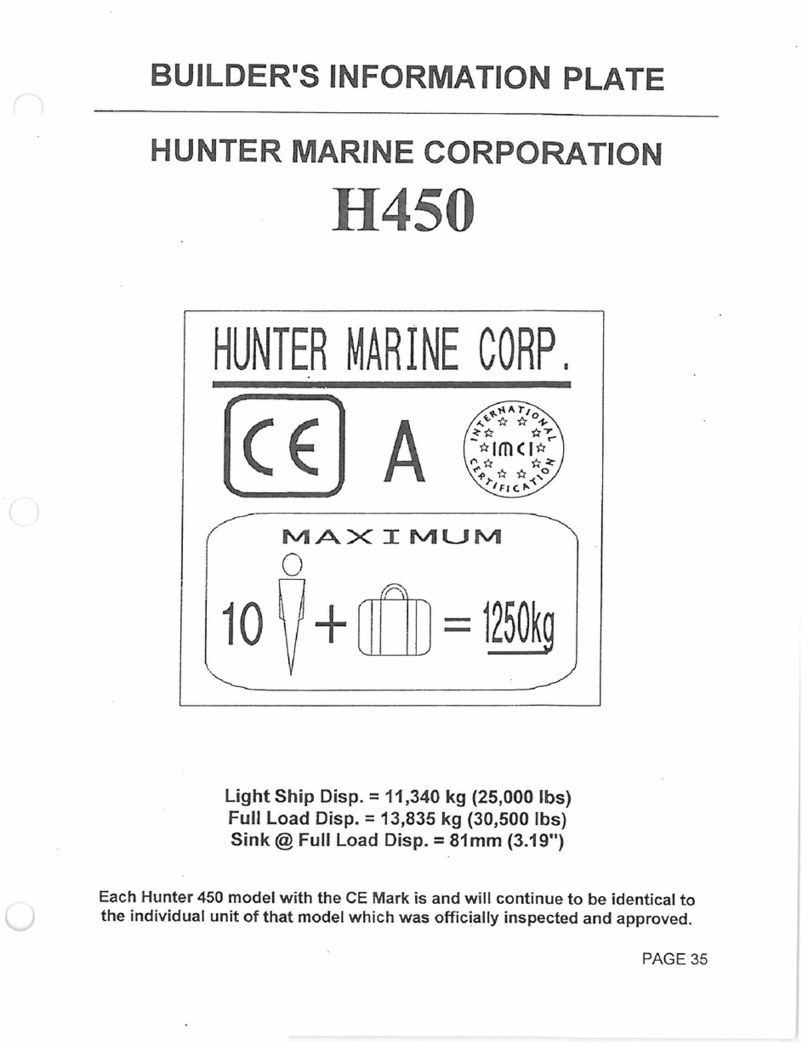
Hunter Marine
Hunter Marine H450 Builder's information plate

Pro-Line Boats
Pro-Line Boats 2950 Walkaround owner's manual
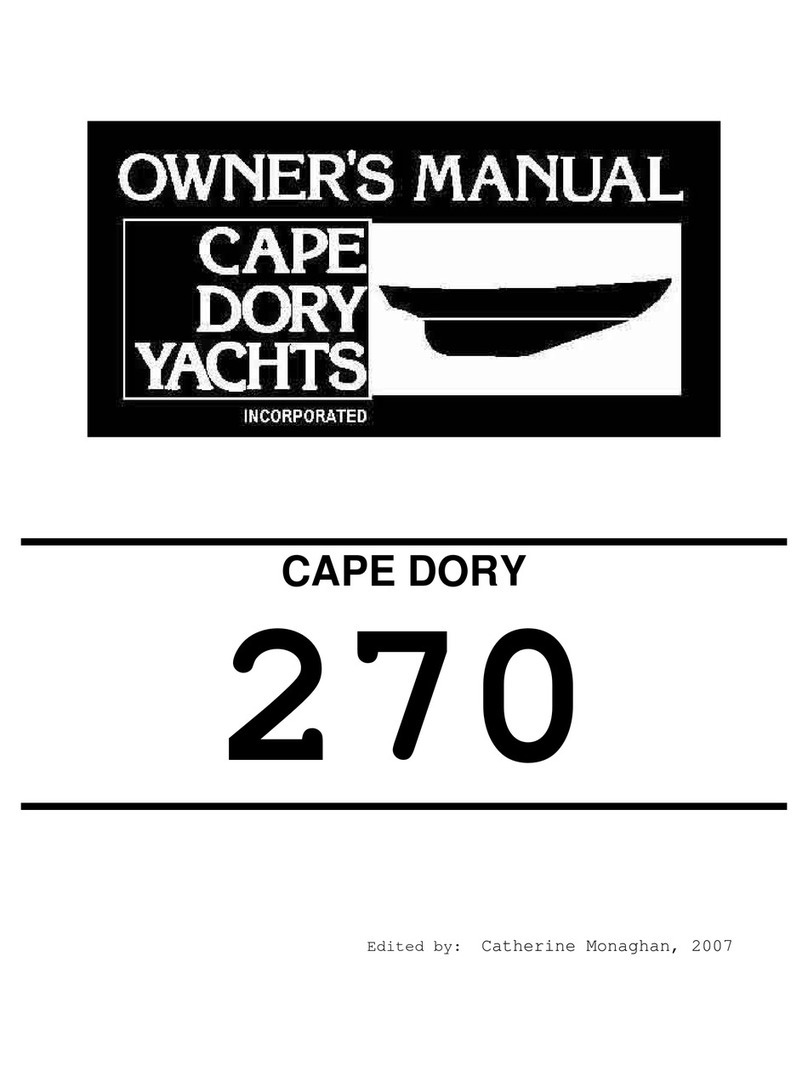
Cape Dory
Cape Dory 270 owner's manual

Sea Eagle
Sea Eagle 300x Instruction & owner's manual
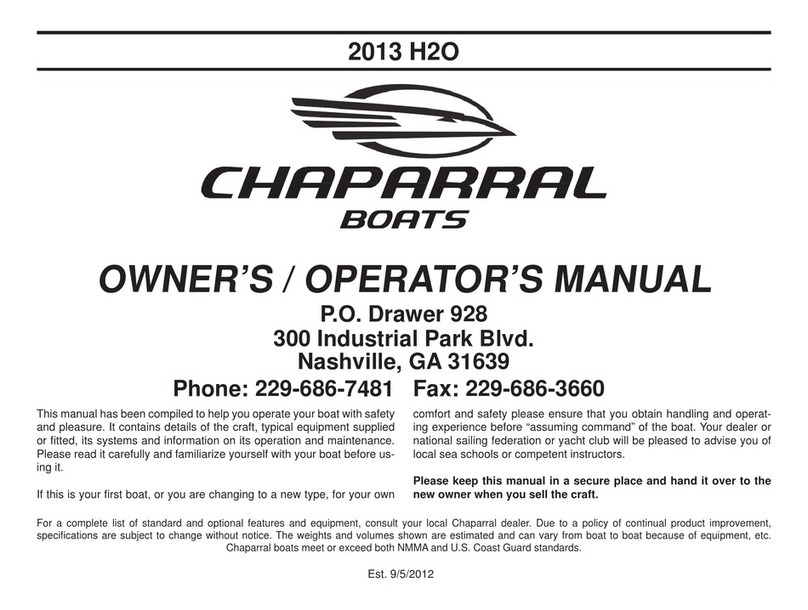
Chaparral
Chaparral H2O 2013 Owner's/operator's manual
